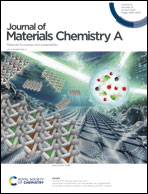Organic piezocatalyst polyimide: molecular structure tailoring and robust built-in electric field†
Abstract
Developing high-performance piezocatalysts has been regarded as an efficacious strategy to promote sustainable development of the environment and energy industry. However, reported piezocatalysts suffer from low conversion efficiency and the majority of them belong to inorganic material systems. Organic polymers have the advantage of easily-tailorable molecular structure, but receive little attention in the piezocatalytic field. In this work, we develop an efficient organic piezocatalyst polyimide (PI) with both structural and morphological superiority by molecular structure tailoring. The decrease of substituted amino groups in melem allows the transformation of the PI molecular structure from planar triangle to linear structure, and the construction of the linear PI using proportional pyromellitic dianhydride (PMDA) and melem shows a considerably increased dipole moment compared to that with a planar molecular structure, thus yielding a robust built-in electric field for promoting the charge separation and transfer. Besides, the nanorod-like morphology allows a stronger mechanical energy harvesting capability, benefiting the production of piezopotential. The polar PI nanorods exhibit a prominent piezocatalytic activity with a RhB degradation ratio of ∼92% within 30 min under ultrasonic irradiation, much faster than that of nanosheet-like PI piezocatalysts and previously reported state-of-the-art organic piezocatalysts. This work offers a new perspective into exploring high-performance organic piezocatalysts via molecular structure engineering.

- This article is part of the themed collection: Journal of Materials Chemistry A HOT Papers


 Please wait while we load your content...
Please wait while we load your content...